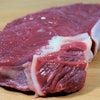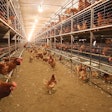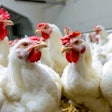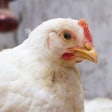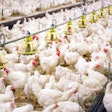
African swine fever is the biggest, but not the only, uncertainty the world’s poultry and livestock producers will grapple with for the remainder of 2019 and into 2020, according Justin Sherrard, global strategist for animal protein with Rabobank’s Food & Agribusiness Research Group.
Speaking at the 2019 Chicken Marketing Summit in Charleston, South Carolina, on July 22, Sherrard said U.S. poultry producers face unprecedented uncertainty with the African swine fever (ASF) outbreak not under control in China and Southeast Asia, U.S. trade deals still up in the air, the particulars of Brexit not decided and very late planting for much of the U.S. corn and soybean crops.

Justin Sherrard, Rabobank (Austin Alonzo)
China
Sherrard said Rabobank forecast pork production in China to decline by 25% from the 2018 total and to decrease another 15% in 2020. He said he has never seen a decline in production of any animal protein like the 13 million tons Rabobank has forecast for pork production in China in 2019.
He said this should create an opportunity for exporters of all meats, but how much of an opportunity will depend on whether the government of China is willing to let per capita meat consumption decline in China over the next few years. As far as the prospects for resolution to the trade disputes between the U.S. and China, Sherrard doubts that ASF will be a game-changer in 2019 or 2020. China may decide they are alright with a reduction in per capita meat consumption.
Even with imports of pork from countries approved to ship to China and increases in domestic poultry production, Rabobank forecasts an 8 million ton shortfall from last year’s consumption of animal protein in China this year. Poultry, beef and sheep meat prices are up to record levels in China already.
China's poultry industry will benefit the most by the reduction in pork availability. Substitution so far is largely in group dining situations. He also predicted we've probably seen the peak of pork consumption in China and it won’t return to past levels even after the outbreak is eradicated. He thinks poultry will eventually take over some of the pounds of consumption lost by pork. The earliest pork production in China might begin to recover will be in 2021.
Southeast Asia
Vietnamese pork production is projected to go down 15 to 20% this year, according to Sherrard, and the disease is also causing problems in Cambodia and Laos. Based on the current trade situations, these Southeastern Asian countries may wind up being more significant trading partners for U.S. poultry and swine producers than China because the U.S. has access to these markets, Sherrard suggested.
U.S. poultry and swine production will increase in 2019. Sherrard expects U.S. chicken meat production to increase 2% this year and rise another 1% in 2020. He said U.S. swine producers instituted more rigorous biosecurity measures in preparation for a possible ASF challenge and this resulted in improved livability and increased production.
Corn and soybeans
The late plantings for corn and soybeans in the Midwest have already resulted in some rising feed costs for U.S. producers, but Sherrard said a few weeks will be needed to know how this will really shake out.


